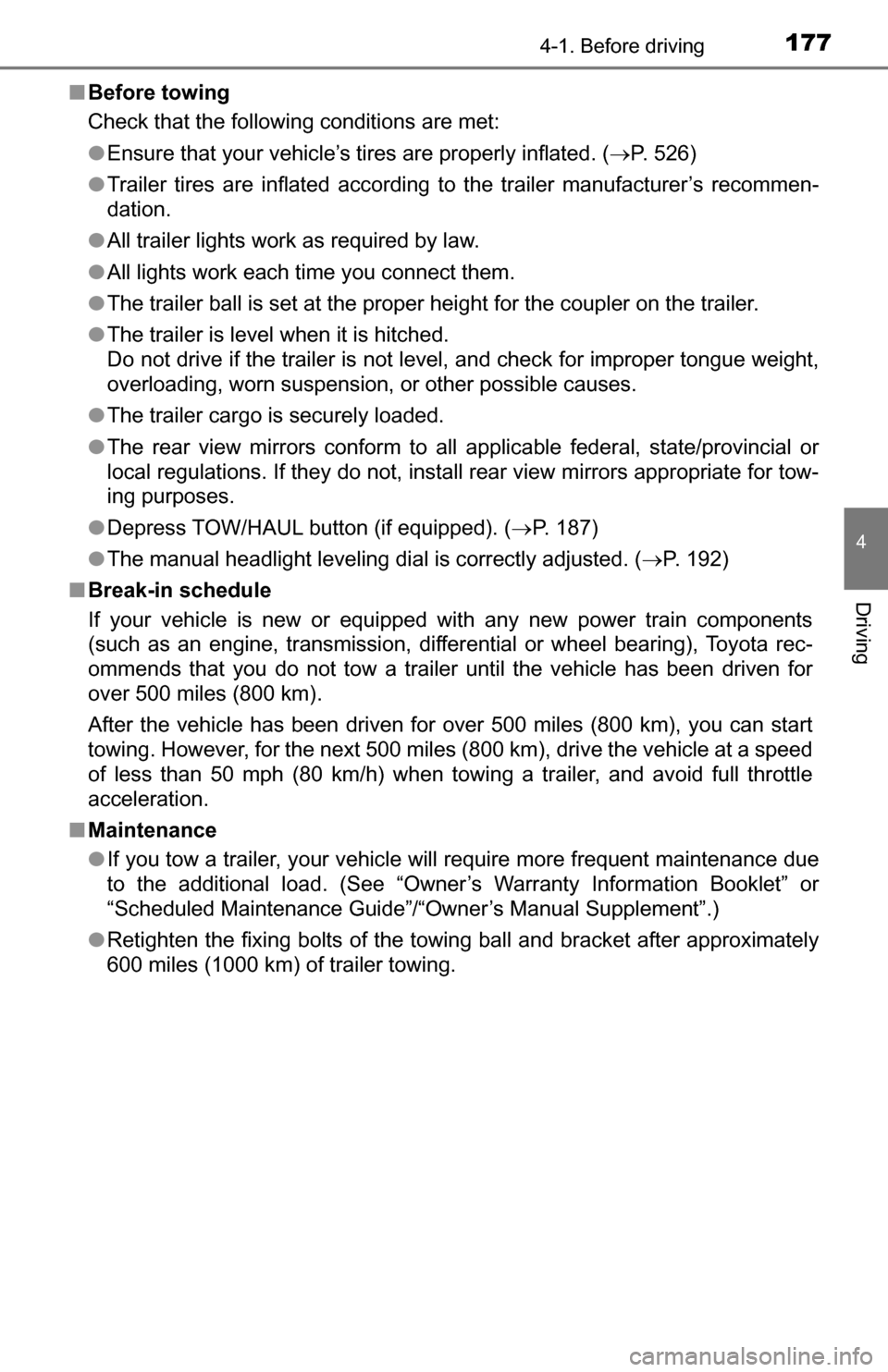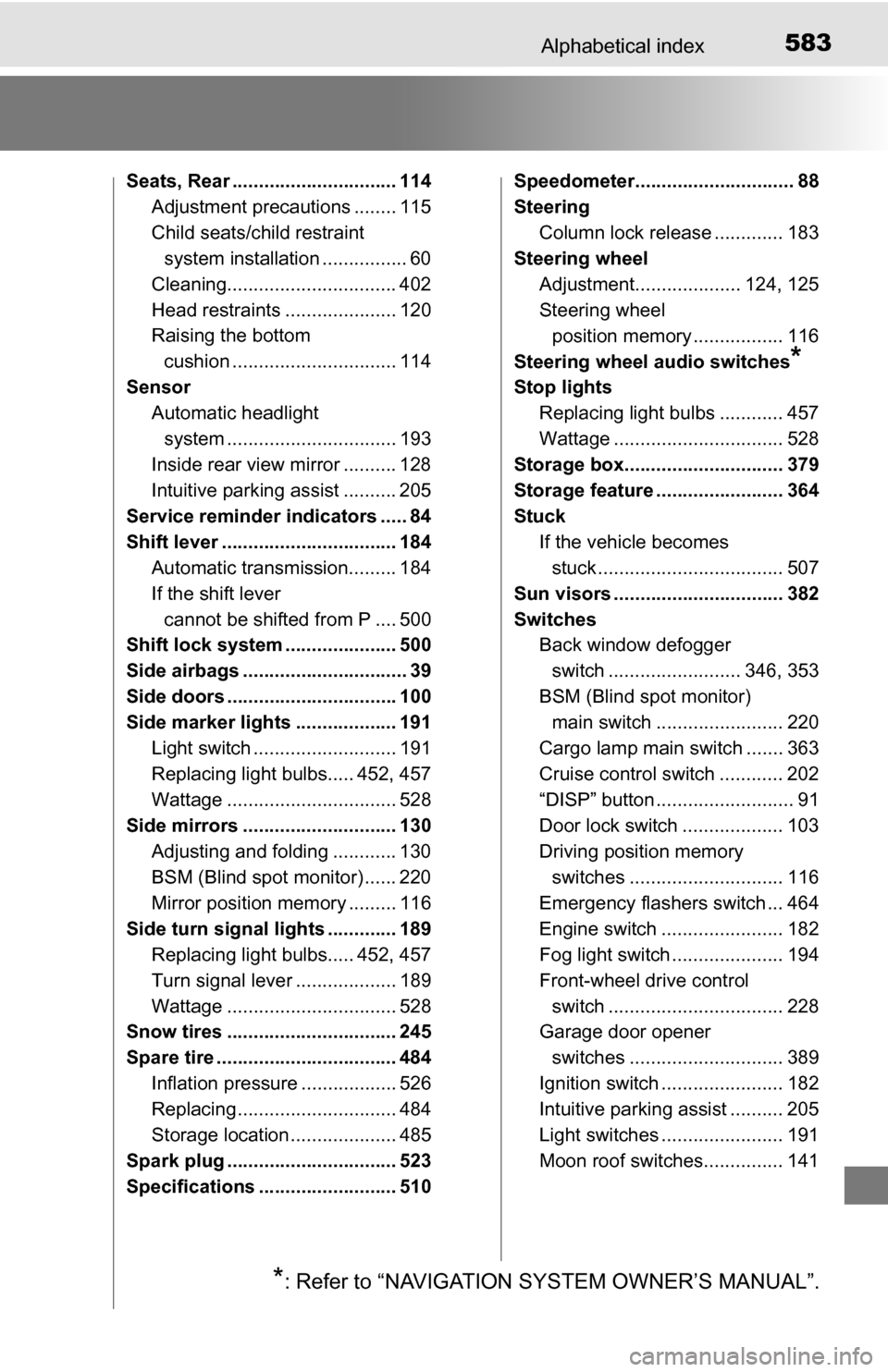Page 177 of 588

1774-1. Before driving
4
Driving
■Before towing
Check that the following conditions are met:
●Ensure that your vehicle’s tires are properly inflated. ( P. 526)
● Trailer tires are inflated according to the trailer manufacturer’s recommen-
dation.
● All trailer lights work as required by law.
● All lights work each time you connect them.
● The trailer ball is set at the proper height for the coupler on the trailer.
● The trailer is level when it is hitched.
Do not drive if the trailer is not level, and check for improper tongue weight,
overloading, worn suspension, or other possible causes.
● The trailer cargo is securely loaded.
● The rear view mirrors conform to all applicable federal, state/provincial or
local regulations. If they do not, install rear view mirrors appropriate for tow-
ing purposes.
● Depress TOW/HAUL button (if equipped). ( P. 187)
● The manual headlight leveling dial is correctly adjusted. ( P. 192)
■ Break-in schedule
If your vehicle is new or equipped with any new power train components
(such as an engine, transmission, differential or wheel bearing), Toyota rec-
ommends that you do not tow a trailer until the vehicle has been driven for
over 500 miles (800 km).
After the vehicle has been driven for over 500 miles (800 km), you can start
towing. However, for the next 500 miles (800 km), drive the vehicle at a speed
of less than 50 mph (80 km/h) when towing a trailer, and avoid full throttle
acceleration.
■ Maintenance
●If you tow a trailer, your vehicle will require more frequent maintenance due
to the additional load. (See “Owner’s Warranty Information Booklet” or
“Scheduled Maintenance Guide”/“Owner’s Manual Supplement”.)
● Retighten the fixing bolts of the towing ball and bracket after approximately
600 miles (1000 km) of trailer towing.
Page 250 of 588

2504-6. Driving tips
NOTICE
■To prevent the water damage
Take all necessary safety measures to ensure that water damage to the
engine or other components does not occur.
● Water entering the engine air intake will cause severe engine damage.
● Water entering the automatic transmission will cause deterioration in shift
quality, locking up of your transmission accompanied by vibration, and ulti-
mately damage.
● Water can wash the grease from wheel bearings, causing rusting and pre-
mature failure, and may also enter the differentials, transmission and
transfer case, reducing the gear oil’s lubricating qualities.
■ When you drive through water
If driving through water, such as when crossing shallow streams, first check
the depth of the water and the bottom of the river bed for firmness. Drive
slowly and avoid deep water.
■ Inspection after off-road driving
● Sand and mud that has accumulated in brake drums and around brake
discs may affect braking efficiency and may damage brake system compo-
nents.
● Always perform a maintenance inspection after each day of off-road driv-
ing that has taken you through rough terrain, sand, mud, or water. For
scheduled maintenance information, refer to the “Scheduled Maintenance
Guide” or “Owner’s Manual Supplement”.
Page 583 of 588

583Alphabetical index
Seats, Rear ............................... 114Adjustment precautions ........ 115
Child seats/child restraint system installation ................ 60
Cleaning................................ 402
Head restraints ..................... 120
Raising the bottom cushion ............................... 114
Sensor Automatic headlight
system ......... ....................... 193
Inside rear view mirror .......... 128
Intuitive parking assist .......... 205
Service reminder indicators ..... 84
Shift lever ................................. 184 Automatic transmission......... 184
If the shift lever
cannot be shifted from P .... 500
Shift lock system ..................... 500
Side airbags ............................... 39
Side doors ................................ 100
Side marker lights ................... 191
Light switch ........................... 191
Replacing light bulbs..... 452, 457
Wattage ................................ 528
Side mirrors ............................. 130 Adjusting and folding ............ 130
BSM (Blind spot monitor) ...... 220
Mirror position memory ......... 116
Side turn signal lights ............. 189 Replacing light bulbs..... 452, 457
Turn signal lever ................... 189
Wattage ................................ 528
Snow tires ................................ 245
Spare tire .................................. 484
Inflation pressure .................. 526
Replacing .............................. 484
Storage location .................... 485
Spark plug ................................ 523
Specifications .......................... 510 Speedometer.............................. 88
Steering
Column lock release ............. 183
Steering wheel Adjustment.................... 124, 125
Steering wheel position memory ................. 116
Steering wheel audio switches
*
Stop lights Replacing light bulbs ............ 457
Wattage ................................ 528
Storage box.............................. 379
Storage feature ........................ 364
Stuck If the vehicle becomes stuck ................................... 507
Sun visors ................................ 382
Switches Back window defogger
switch ......................... 346, 353
BSM (Blind spot monitor) main switch ........................ 220
Cargo lamp main switch ....... 363
Cruise control switch ............ 202
“DISP” button .......................... 91
Door lock switch ................... 103
Driving position memory switches ............................. 116
Emergency flashers switch ... 464
Engine switch ....................... 182
Fog light switch ..................... 194
Front-wheel drive control switch ................................. 228
Garage door opener
switches ............................. 389
Ignition switch ....................... 182
Intuitive parking assist .......... 205
Light switches ....................... 191
Moon roof switches............... 141
*: Refer to “NAVIGATION SYSTEM OWNER’S MANUAL”.